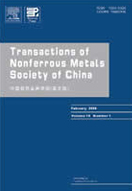Effects of weld reinforcement on tensile behavior and mechanical properties of 2219-T87 aluminum alloy TIG welded joints
(1. China Academy of Launch Vehicle Technology, Beijing 100076, China;
2. Capital Aerospace Machinery Company, Beijing 100076, China;
3. Department of Mechanical Engineering, Tsinghua University, Beijing 100084, China;
4. Key Laboratory for Advanced Materials Processing Technology, Ministry of Education,
Tsinghua University, China;
5. Joining and Welding Research Institute, Osaka University, Osaka, Ibaraki 567-0047, Japan
Received 23 May 2016; accepted 29 November 2016)
2. Capital Aerospace Machinery Company, Beijing 100076, China;
3. Department of Mechanical Engineering, Tsinghua University, Beijing 100084, China;
4. Key Laboratory for Advanced Materials Processing Technology, Ministry of Education,
Tsinghua University, China;
5. Joining and Welding Research Institute, Osaka University, Osaka, Ibaraki 567-0047, Japan
Received 23 May 2016; accepted 29 November 2016)
Abstract: Tungsten inert gas (TIG) welded joints for 2219-T87 aluminum alloy are often used in the fuel tanks of large launch vehicles. Because of the massive loads these vehicles carry, dealing with weld reinforcement on TIG joints represents an important issue in their manufacturing and strength evaluation. Experimental and numerical simulation methods were used to investigate the effects of weld toe shape and weld toe position on the tensile behavior and mechanical properties of these joints. The simulation results indicated that the relative difference in elongation could be as large as 96.9% caused by the difference in weld toe shape. The joints with weld toes located in the weld metal or in the partially melted zone (PMZ) exhibited larger elongation than joints with weld toes located at the juncture of the weld metal and the PMZ.
Key words: tensile strength; weld reinforcement; 2219-T87 aluminum alloy; TIG welding; digital image correlation (DIC) technique

